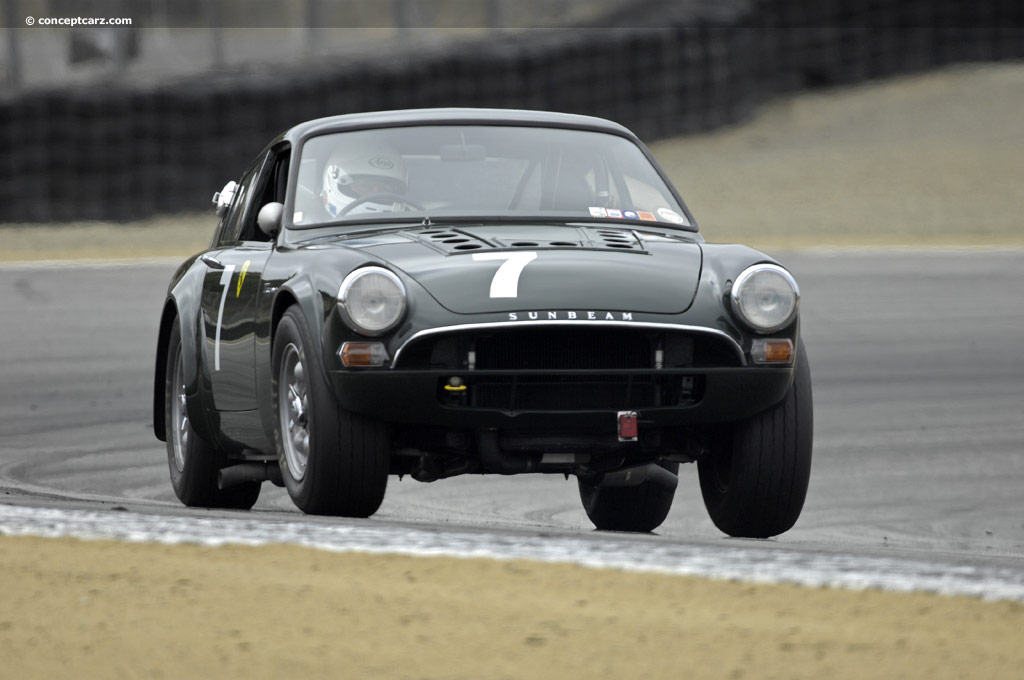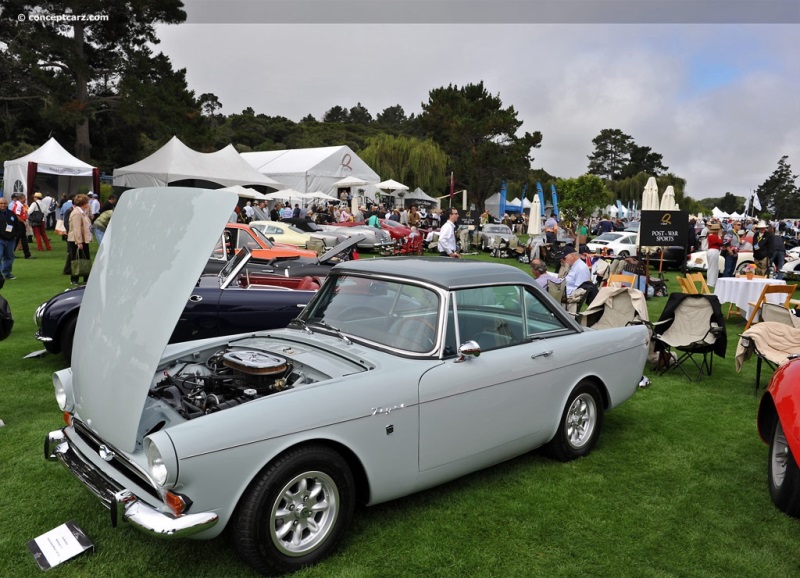1964 Sunbeam Tiger Navigation
A Balmoral Grey Sunbeam Tiger was introduced in 1964 at the New York Auto Show and the model would remain in production through 1967. Its inception, however, began years earlier when in 1962, Carroll Shelby was enlisted to engineer a V-8 powered prototype for the Rootes Group's Sunbeam Alpine. The Alpine was modified to house a Ford 260 cubic-inch V8 with a four-speed manual transmission, and the Tiger was born. Although the Tiger was aligned with Shelby's quest to bring American horsepower to British sports cars, the idea had initially been proposed by Jack Brabham in 1962. The resulting prototype was compelling, and production was quickly greenlit.
Sport Roadster
Chassis #: B9470605
View info and historyThe Sunbeam Motor Car Company was founded in 1905 by John Marston and business partner Maxwell Maberly-Smith, initially producing cars based on a Peugeot design. During the 1920s and 1930s, the company earned worldwide acclaim with a series of racing and speed-record machines. They were eventually absorbed by Rootes which silenced its models with performance aspirations, laying dormant until the arrival of the Sunbeam Alpine roadster in 1959. It was a sporty four-cylinder two-seater model with refined ride and interior along with amenities that included roll-up side windows. By this point in history, American manufacturers were actively appealing to the performance market, a fact noticed by West Coast Rootes Group sales manager Ian Garrad. Formula 1 champion Jack Brabham proposed the idea to Garrad of fitting the Alpine with a Ford V8 engine. Garrad passed the information on to his son Ian, then the West Coast Sales Manager of Rootes American Motors Inc. Ian had witnessed similar V8 conversions where he lived, near Carroll Shelby's Shelby American operation. After measuring the engine bay of the Alpine, Ian despatched his service manager Walter McKenzie to local new car dealerships to find an engine that might fit. His quest had led him to a Ford dealership that had a 260 CID V8 which appeared suitable and was relatively light at 440 pounds. Shelby, being the logical choice due to experience and location, was asked to calculate the cost and time to create a prototype. His answer of eight weeks and ten thousand dollars was relayed to Brian Rootes, head of sales for the Rootes Group, for permission to proceeded. With permission obtained, the construction of the prototype began.During this process, Ian Garrad fast-tracked the idea via fabricator Ken Miles, who was given a budget of less than a thousand dollars, a Series II Alpine, a two-speed automatic transmission, and a Ford V8 engine. Within a week, Miles had installed the V8 and proven the idea feasible. Shelby's prototype, known as the white car, was completed in April of 1963 and tested shortly thereafter. Its Ford V8 engine was only 3.5 inches longer than the four-cylinder engine originally housed in the engine bay, and unlike the prototype built by Miles, used a Ford four-speed manual transmission. What both V8 prototypes shared was the fact that the engines just barely fit within the engine bay. 
Sport Roadster
Chassis #: B9470605
View info and historyThe creation of the prototypes had been done without knowledge or approval by Lord Rootes, who reluctantly agreed to have the Shelby prototype sent to Europe in July of 1963 for him to review. A test drive quickly displaced any aggravations and he quickly contacted Henry Ford II directly to negotiate a deal for the V8 engines. The order for 3,000 engines represented the largest order Mr. Ford had ever received for his engines from an automobile manufacturer. The 1964 New York Motor Show was selected for the unveiling of the new V8-powered Sunbeam, provisionally known as the Thunderbolt, which meant engineers had just eight months to get it ready for production. The prototypes had proven that the engine would fit, but numerous modifications were needed to cope with the heavier and more powerful engine, including chassis updates. To complicate things even further, Sunbeam decided to produce the vehicle in England rather than outsourcing the work to Shelby, due to concerns about his relationship with Ford. Since the Rootes factory at Ryton lacked the space and capacity to build the Tiger, the work was contracted to Jensen in West Bromwich. This worked well for both Shelby and Jensen, as Shelby was paid a royalty on each Tiger built, and Jensen had just finished its contract with Volvo (for production of the P1800). The painted and trimmed bodies were supplied by Pressed Steel in Oxfordshire. The engines and gearboxes were delivered directly from Ford in America. Prior to the close of 1963, Jensen completed fourteen prototype examples on the Series IV body shell. Production commenced in June of 1964 and soon Jensen was assembling up to 300 Tigers a month. The early examples received a Borg-Warner four-speed all-synchromesh manual gearbox, while Ford worked on resolving its supply problems. 
Sport Roadster
Chassis #: B9499999The Sunbeam Tiger, initially offered solely to the American market, had an 86-inch wheelbase, a length of 156-inches, and a height of 51.5-inches. Its 260 cubic-inch V8 engine used a single Ford two-barrel carburetor and produced 164 horsepower, but with minimal tuning could be tweaked to deliver upwards of 245 horsepower. The steering was courtesy of a precise rack and pinion system and stopping power was by Girling-manufactured brakes with 9.85-inch discs at the front and 9-inch drums at the rear. The front suspension was independent with coil springs while the rear had a live axle and semi-elliptic springs. This was a similar setup to the one used on the Alpine, albeit with stiffer front springs and a Panhard rod to better locate the rear axle. To help with weight distribution, the battery was moved from beneath the rear seat to the trunk (boot). The exterior styling of the Tiger was similar to the Alpine, distinguished by a Tiger logo and 'Powered by Ford 260' badges on each front wing. All but 56 examples of the 1,649 Mark I Tigers produced in 1964 were shipped to North America with a base price of $3,499. The U.K. market was able to purchase the Mark I beginning in March of 1965 at a price of £1446. It was also sold in South Africa for R3350, badged as the Sunbeam Alpine 260.
Sport Roadster
Chassis #: B9470605
View info and historyThe Sunbeam Tiger was produced over three distinct series, however, the factory only ever designated two, the Mark I and Mark II. Sunbeam Tiger enthusiasts generally designate a third series representing the body style change from the Series IV Alpine panels to the Series V panels. This took place during Mark I production and the later built Mark I cars are unofficially known as Mark IA.The Sunbeam Tiger Mark II was built in 1967 with 633 units produced. It wore the Mark IA bodywork and was powered by a larger Ford 289 cubic-inch V8. These vehicles were sold exclusively to America at $3,840 and never marketed in the United Kingdom. However, six right-hand drive examples were sold to the Metropolitan Police and four more went to (VIP) Rootes dealerships. In June of 1964, Chrysler paid £12.3 million for a large stake in the Rootes Company, and later in the year was allowed by the U.K. government to acquire a controlling interest in the company. Chrysler was not keen on powering the Tiger with its competitor's engine, but Chrysler's 273 small-block V-8 was too large to fit in the engine bay. 
Sport Roadster
Chassis #: B9470605
View info and historyWhen the Mark II entered production, Chrysler was in control of Rootes, so the 'Powered by Ford' shields were replaced with 'Sunbeam V-8' badges. When Rootes' stock of Ford V8 engines was depleted, Chrysler brought production of the Tiger to an end. Chrysler would later resurrect the Tiger name in 1972 and applied it to the Avenger Tiger, a limited-edition modified Hillman Avenger. A total of 7,083 examples of the Sunbeam Tiger were built from 1964 through 1967.
by Daniel Vaughan | Feb 2022

Sport Roadster
Chassis #: B9470605
View info and history
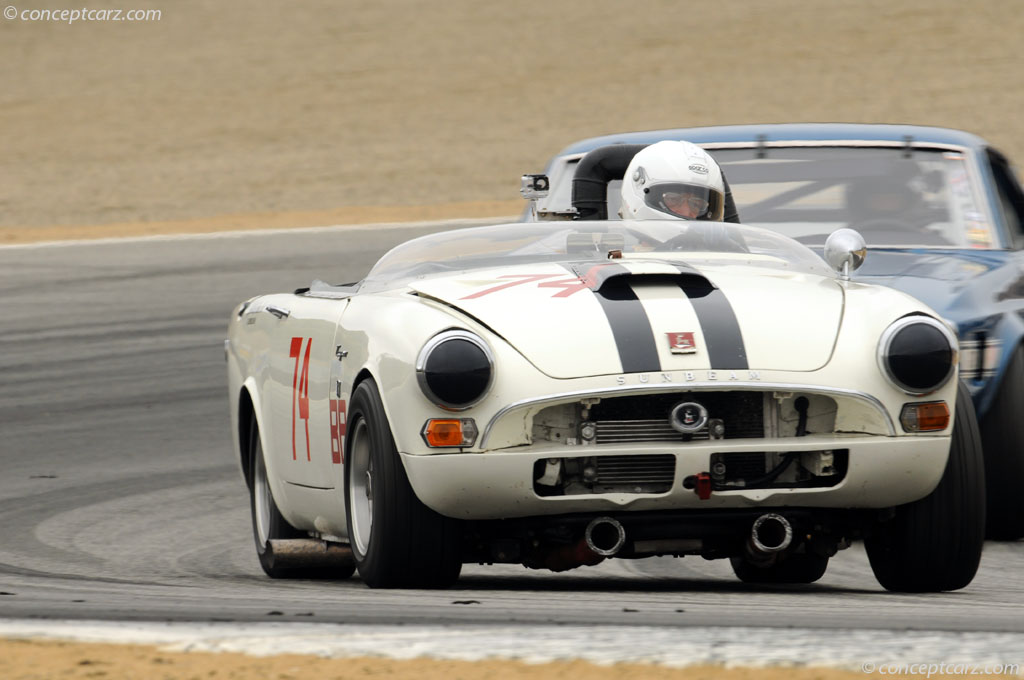
Sport Roadster
Chassis #: B9470605
View info and history
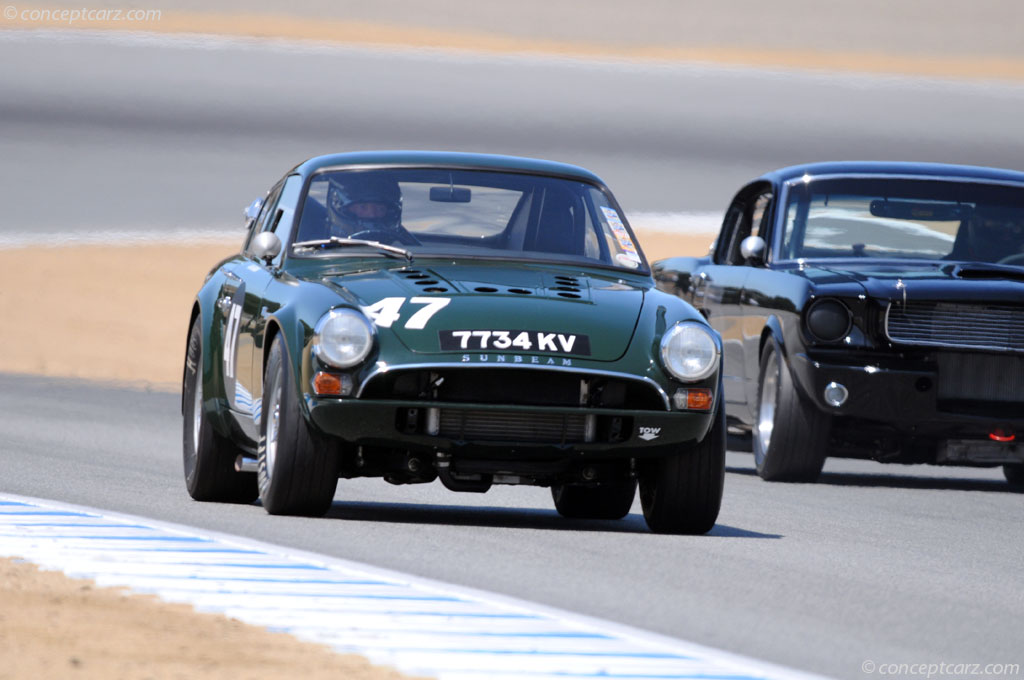
Sport Roadster
Chassis #: B9499999
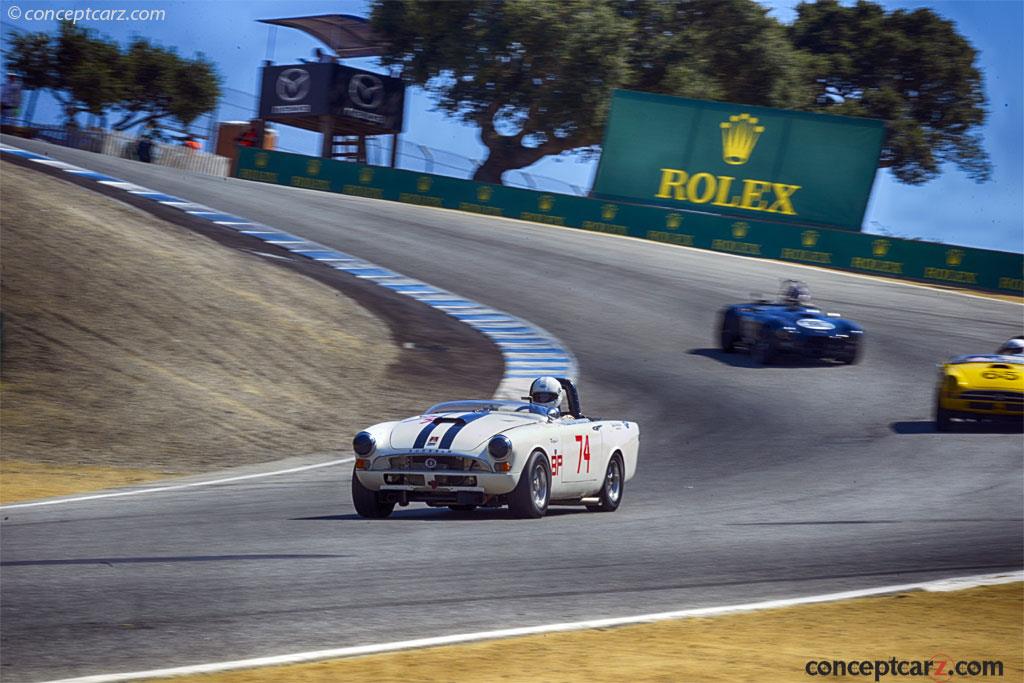
Sport Roadster
Chassis #: B9470605
View info and history

Sport Roadster
Chassis #: B9470605
View info and history
by Daniel Vaughan | Feb 2022
Related Reading : Sunbeam Tiger History
Lord William Rootes of Ramsbury created the British-based SunbeamRootes Coventry Company after extensive experience gained from the Singer Company. He had been actively involved in automobile racing and development for a number of years. In 1926 a Sunbeam powered by a 12-cylinder engine and driven by Sir Henry Seagrave had set the land speed record at 152.3 mph. The Sunbeam Tiger is probably most....
Continue Reading >>
Continue Reading >>
- 1964 Sunbeam Tiger Menu
- Article
- Image gallery
- Valuation
- Specifications
- Profiles
- Production figures
Sunbeam
Similarly Priced Vehicles
1964 Sunbeam Tiger Vehicle Profiles
Recent Vehicle Additions
Performance and Specification Comparison
Price Comparison
$2,570 - $2,750
Tiger Specification Comparison by Year
Year
Production
Wheelbase
Engine
Prices
7,083
86.00 in.
8 cyl., 260.00 CID., 164.00hp
8 cyl., 289.00 CID., 200.00hp
8 cyl., 289.00 CID., 200.00hp
$3,400 - $3,400
Related Automotive News

Renowned Racing Legends Grant Exclusive Nod to the Rolex Monterey Motorsports Reunion for New Run Groups
As the Rolex Monterey Motorsports Reunion celebrates the Golden Anniversary of historic racing at Montereys WeatherTech Raceway Laguna Seca, the illustrious gathering also honors the history and significant achievements throughout time. It seems fitting...

Rolex Monterey Motorsports Reunion : Unbridled Passion
Today, when John Atzbach of Seattle drove his 1965 Shelby GT 350 Mustang through the turns and straights of Mazda Raceway Laguna Seca, it was not because he was rehearsing for the upcoming weekend of racing at the Rolex Monterey Motorsports Reunion....
Rolex Monterey Motorsports Reunion to Celebrate 50th Anniversary of Shelby GT350 Mustang
MONTEREY, Calif., November 17, 2014 —The Rolex Monterey Motorsports Reunion will celebrate the 50th anniversary of one of the most recognizable road racing cars of the 60s – the Shelby GT350 Mustang – as the 2015 featured marque August 13-16,...

Sonoma Historic Motorsports Festival Celebrates Corvette'S 60 Years At Sonoma Raceway
Fast cars, fine food and wine highlight May 18-19 weekend
Paul Reinhart is honored guest, popular racing seminar scheduled for second year
SONOMA, Calif. (April 27, 2013) - The Sonoma Historic Motorsports Festival returns to Sono...

Shelby Heritage Display Features Rarest of the Rare at Rolex Monterey Motorsports Reunion
Complementing the impressive number of authentic competition Shelby Cobras thundering around the circuit in their dedicated race group (3A) at this years Rolex Monterey Motorsports Reunion, August 17-19, will be a collection of unequalled magnitude...
